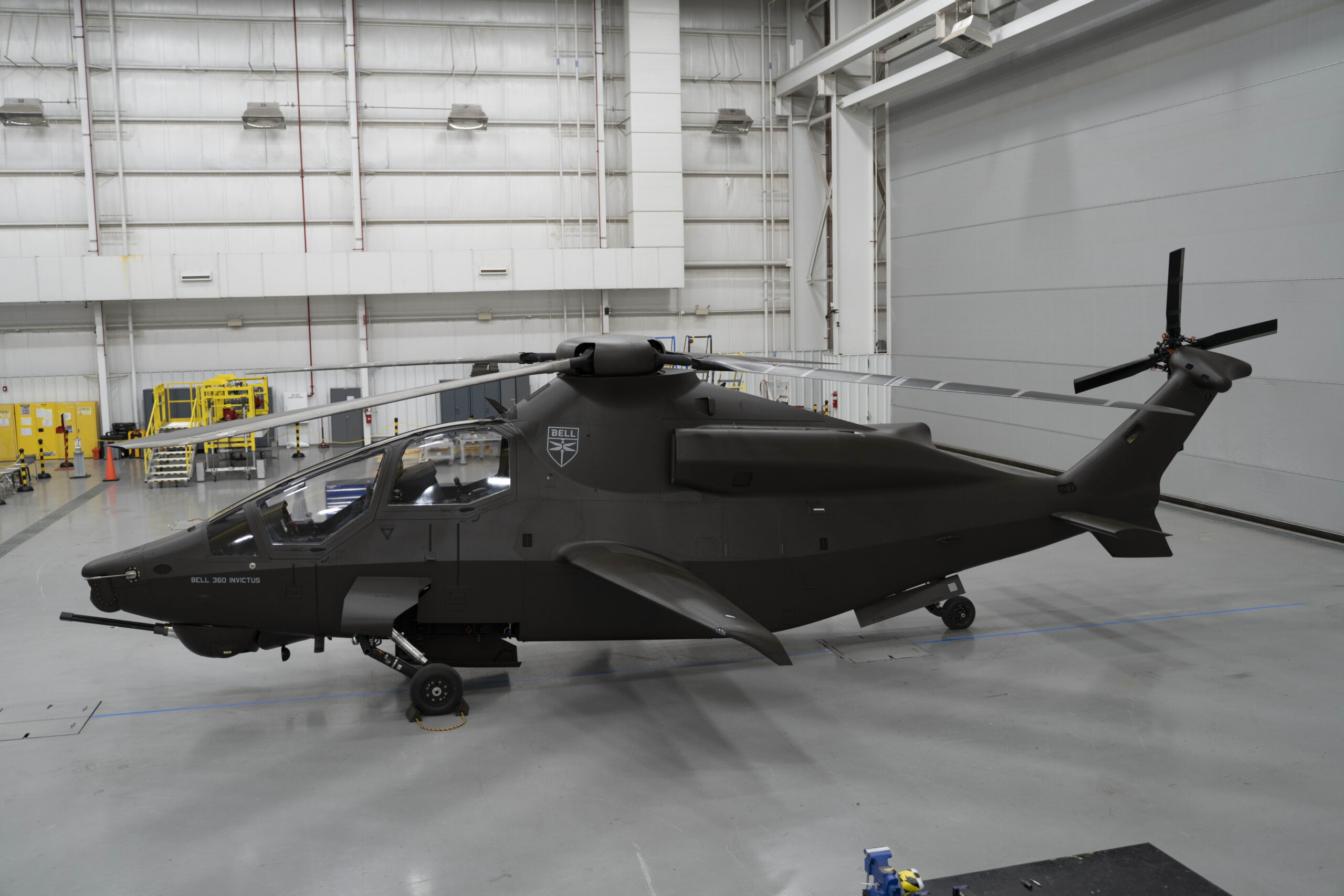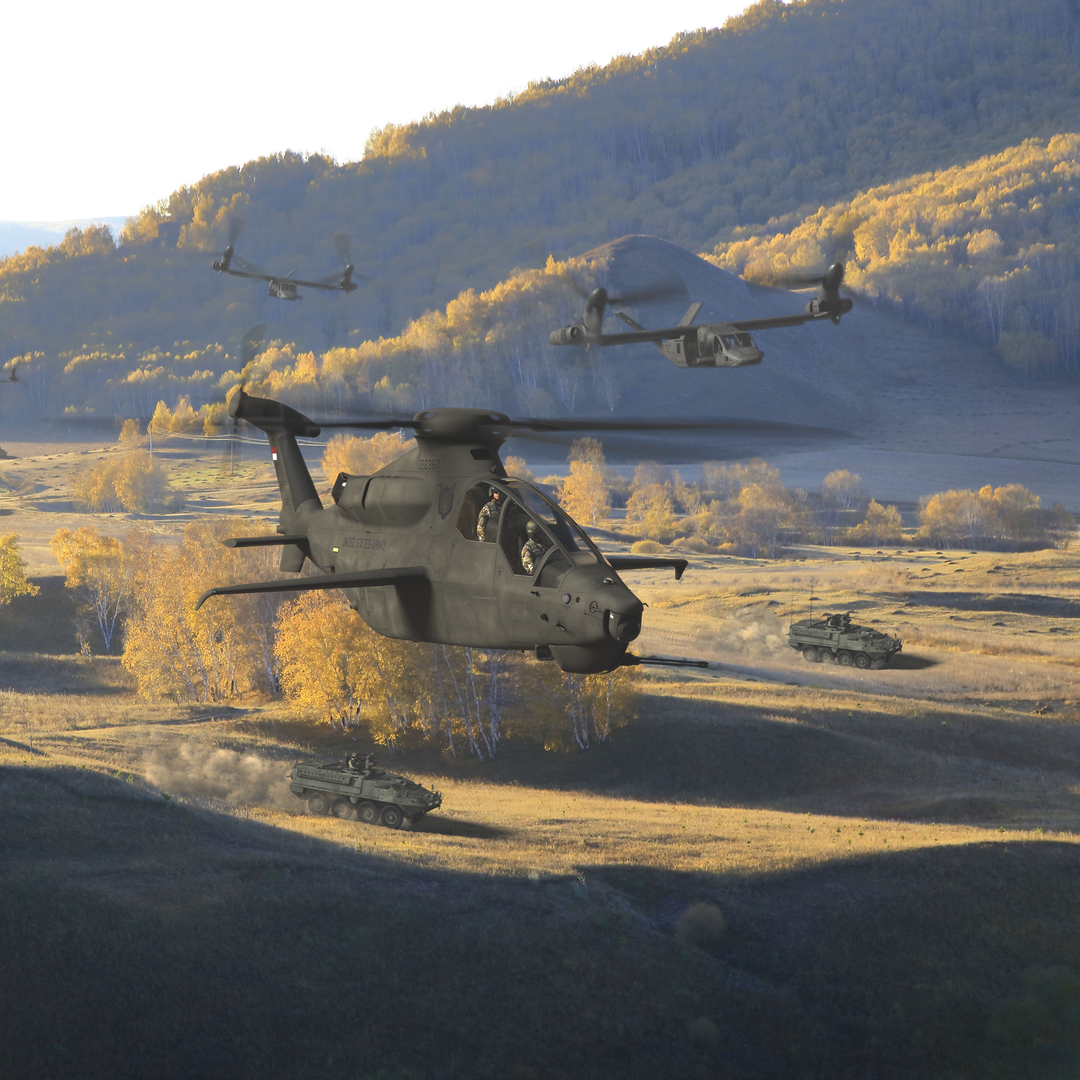
Third parties will be able to plug and play their capabilities onto the Bell 360 Invictus for the Army’s FARA program, enabling competition and affordability. FARA photo by Bell Textron.
In this Q&A with Chris Gehler, Bell Textron Inc.’s senior vice president and program director for FARA, we discuss the company’s implementation of the Modular Open Systems Approach (MOSA) for its Bell 360 Invictus FARA candidate that builds on its winning V-280 Valor FLRAA.
Breaking Defense: What’s the threat environment that drives the need for FVL with MOSA?
Gehler: Peer and near-peer adversaries in Eastern Europe, the Indo-Pacific, and the Middle East all come to mind with significant capabilities in advanced and integrated air defense systems, GPS-denied environments, and other rapidly evolving threats.
Army modernization for Future Vertical Lift with native MOSA capabilities support priorities to build a more lethal force while providing greater performance and affordability. Rather than having federated, closed systems that require them to be broken into to upgrade software, the Army will be able to rapidly upgrade the capability on these aircraft to adapt to threats or to incorporate mission capability such as more lethal systems.
For example, if you want to include a new long-range precision missile that is able to provide greater standoff and lethality in a war zone but wasn’t originally on the aircraft, you might be able to integrate that within months instead of years using open standards.
Army aviation modernization incorporating MOSA principles into the enduring fleet also takes a significant step forward in affordability and business practices with FVL. One of the greatest threats to our defense is the lack of affordability in maintaining overmatch capabilities.
You asked about the threat environment, well, high cost or unaffordability is certainly a threat. When we become unaffordable, when systems become so costly that they consume more and more of the budget, then decision makers are forced to prioritize and therefore cut back on capability.
We’re looking to provide the maximum amount of capability, in this case overmatch capability. The ability to be more affordable through the use of both MOSA and standards on FVL – business practices that also include the IP and data rights – is what sets the FVL programs apart from the entire fleet.
When you can afford things, it’s much easier to quickly bring those overmatch capabilities to the warfighter.
Breaking Defense: Discuss the interfaces and other software modifications that make open systems available on FLRAA and FARA.

Chris Gehler is Bell Textron’s senior vice president and program director for the Army’s Future Attack Reconnaissance Aircraft.
Gehler: The designation of key interfaces with open standards is somewhat analogous to implementing USB standards on computers that allow for plug-and-play type operations by differing vendors not associated with the computer manufacturers. You can have more affordability and innovation from a greater number of players, which gives you more capabilities or even essential capabilities from the implementation of open standards in a cost-competitive environment.
We’re not going to require anybody to adapt to a Bell standard. We’re meeting an Army directed MOSA standard in their architecture.
Everyone in that same ecosystem knows what they need to do to be able to plug in and to play on the system, whether it’s our FLRAA weapon system or FARA weapon system. They know what the interfaces are, the standards are there, and they can plug and play their capabilities, which enables more competition which drives affordability.
Breaking Defense: Give us some examples of how you are implementing MOSA and the common digital backbone on FARA and FLRAA, especially as it relates to operationalizing capabilities such as launched effects (LE)?
Gehler: Though our FLRAA and FARA are different weapon systems, at the heart of both aircraft is a common, open architecture digital backbone that is the lifeblood, the central nervous system that enables our MOSA approach.
What that means in one example is that the common-digital-backbone approach enables ease of maintenance on the flight line with common tools and techniques that allows for a common Military Occupational Specialty maintainer to service these critical systems. It also means better affordability because there’s more economy of scale on purchasing power, as I mentioned.
The flight control computers are identical, too. The fly-by-wire architecture employs the same approach, the electrical systems have identical parts, and the actuation systems share common interfaces. This high degree of commonality across systems provides ease of maintainability for our Soldiers and affordability for our customers.
To your point on the operationalization of that digital backbone, exchange points and interfaces throughout the aircraft allow us to integrate new off-the-shelf native capabilities, as well as
legacy capabilities such as survivability systems operating off of older 1553 databuses. We can integrate those onto the aircraft through exchange points that translate that database into Time Sensitive Networking standards (TSN).
You mentioned LE and we have a modular effects launcher on the Bell 360 Invictus that is a MOSA launcher. Launch effects that are new can seamlessly integrate onto the aircraft through the modular effects launcher. There might be a bit more integration for launched effects that are legacy, but the Army is driving open standards at the weapons systems themselves.

Bell’s 360 Invictus FARA candidate builds on its winning V-280 Valor FLRAA platform with a common, open architecture digital backbone that enables MOSA. Illustration by Bell Textron.
Breaking Defense: What sets FLRAA and FARA apart from your competitors with regard to MOSA?
Gehler: Bell is in lockstep with our Army customer to provide overmatch capabilities of lethality, reach, and protection, along with other MOSA-related objectives such as lifecycle affordability. We’ve proven this with the Army’s selection of the Bell V-280 Valor for FLRAA and are proving it within our Open Systems Verification Demonstration (OSVD) events on FARA with the Bell 360 Invictus. We don’t want to have vendor lock or to lock out suppliers, and we’re aligned with the Army on this.
At the core of both FVL weapon systems is an integrated modular avionics (IMA) architecture and open processing environment that can be used in multiple applications. That replaces federated architectures where each individual subsystem has dedicated hardware with closed, proprietary interfaces. The outcome of this approach is: reduced lifecycle costs with fewer dedicated subsystems; dematerializing components that reduce space, weight, and power requirements, and integrated open standards such as Future Airborne Capability Environment (FACE) and Hardware Open Systems Technologies (HOST).
The common digital backbone utilizing Time Sensitive Networking that we discussed earlier is central to this architecture in controlling the sequencing of safety critical data. All critical data on the network has a sequence of deterministic time at which it needs to be there with flight-critical data prioritized at the top. Data that is of lesser priority is deprioritized, if you will, and we’re talking about hundredths of seconds. Those time differences and sequences do matter and that’s why Time Sensitive Networking with critical software techniques make this a very reliable approach to what we’re doing.
At the edges of the backbone are either newer native TSN systems or an exchange point to integrate enduring systems with older standards such as MIL-STD-1553. All of this is done in a cyber-secure environment following flight-critical software standards. Integrating general purpose processing with open standards and interfaces and dematerializing once-federated components lets the customer rapidly and affordably upgrade system capabilities.
Our common, advanced fly-by-wire systems and common digital backbones also pave the way from piloted flight to autonomy as we have already shown during the V-280 Joint Multi-Role Technology Demonstration.
In some mission scenarios, it may be preferential to reduce the number of pilots from two, to one, or to none. Our digital backbone on FARA and FLRAA has everything you need to plug in an autonomous mission application, for example, or a portion of general computing dedicated to autonomy.
While moving Soldiers around the battlefield may always demand aviators on the controls, moving aircraft and or supplies may not. The reconnaissance mission requires human curiosity and clearance of fires may require human decisions extending reach. As autonomy develops, there will be more opportunities to incorporate it into operational scenarios. Both FARA and FLRAA weapon systems provide the Army a low-risk path forward to integrating autonomy into Army aviation in support of multi-domain operations.
Breaking Defense: Final Thoughts?
Gehler: MOSA is an Army Aviation top priority that improves readiness, affordability, and innovation. It allows companies of all sizes to offer cutting-edge technology and eliminates the opportunities for vendor lock. At Bell, we are not only focused on developing superior performance in our aircraft — speed, reach, and lethality — but also focused on providing affordable systems that are easily maintainable within our Army’s formations. Our objectives align with the Army’s objectives to provide overmatch lethality and protection to our Soldiers before our adversaries can adapt.
This research was partially funded by the Government under Agreement No. W911W6-19-9-0002. The U.S. Government is authorized to reproduce and distribute reprints for Government purposes notwithstanding any copyright notation thereon.
The views and conclusions contained in this document are those of the authors and should not be interpreted as representing the official policies, either expressed or implied, of the Technology Development Directorate, or the U.S. Government.























